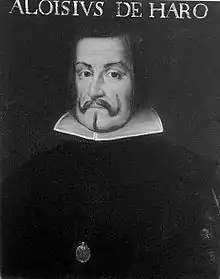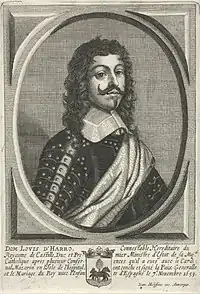Luis Méndez de Haro
Luis Méndez de Haro, 6th Marquis of Carpio or Luis Méndez de Haro y Guzmán, Grandee of Spain, (in full, Spanish: Don Luis Méndez de Haro Guzmán y Sotomayor de la Paz, sexto marqués del Carpio, segundo conde de Morente, quinto conde y tercer duque de Olivares, segundo marqués de Eliche, primer duque de Montoro, 3 veces Grande de España, Comendador mayor de la Orden de Alcántara, Gran Chanciller de las Indias, Alcaide de las Alcázares de Sevilla y Córdoba, Caballerizo mayor, gentilhombre de cámara y primer ministro de Felipe IV y su gran privado), (1598 – 26 November 1661), was a Spanish nobleman, political figure and general.

Biography
Luis Méndez de Haro y Guzmán was the son of don Diego de Haro, the marquis of Carpio, and of doña Francisca de Guzmán, the sister of the Count-Duke Olivares.
Méndez de Haro made a career at the Spanish court under the protection of his uncle, the Count-Duke Olivares, whom he had succeeded as Valido or the court favourite who enjoys the friendship and trust of the king and who wields political power, after the Count-Duke was driven from office in 1643. He would never exert the same type of influence or control as his uncle had, mainly due to King Philip IV's reliance upon Sister María de Ágreda's counsel. She was able to influence the king to abolish the function of valido.

Luis de Méndez Haro was the main Spanish negotiator of the Treaty of the Pyrenees on Pheasant Island in 1659. He was unable to avoid any perceived negative result of the treaty, nor was he able to reach an anti-French accord with the Lord Protector of the Commonwealth of England, Scotland, and Ireland, Oliver Cromwell. The treaty was accompanied by the marriage of King Louis XIV of France and the Infanta Maria Theresa of Spain. Luis de Méndez Haro played the part of the bridegroom in the proxy marriage that took place at Fuenterrabia on June 3, 1660.
Méndez de Haro's main success was the suppression of the Catalan uprising, and the reconquest of Barcelona in 1652.
His campaign during the Portuguese Restoration War on the contrary was a complete failure. Luis de Méndez Haro personally led Spanish troops at the Battle of the Lines of Elvas in 1659, which had ended in total defeat.
On April 26, 1625, in Barcelona, Luis de Méndez Haro had married Catalina (April 26, 1610 – November 19, 1647), the youngest daughter of Enrique de Córdoba Cardona y Aragón. They had 6 children:
- Gaspar, (1629–1687), his successor and the Viceroy of Naples.
- Juan Domingo (1640–1716), Governor of the Habsburg Netherlands and the Viceroy of Catalonia.
- Francisco
- Antonia, who had married Gaspar Juan Pérez de Guzmán, 10th Duke of Medina Sidonia.
- Manuela, who had married Gaspar Vigil de Quiñones Alonso Pimentel y Benavides.
- María Méndez (1644–1693), who had married Gregorio María Domingo de Silva Mendoza y Sandoval.
Sources
- Hobbs, Nicolas (2007). "Grandes de España" (in Spanish). Retrieved 15 October 2008.
- Instituto de Salazar y Castro. Elenco de Grandezas y Titulos Nobiliarios Españoles (in Spanish). periodic publication.
| Spanish nobility | ||
|---|---|---|
| Preceded by Diego López de Haro |
VI Marques del Carpio 1469–1528 |
Succeeded by Gaspar Méndez de Haro |